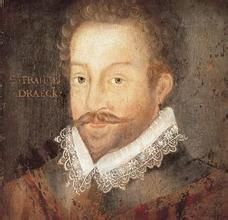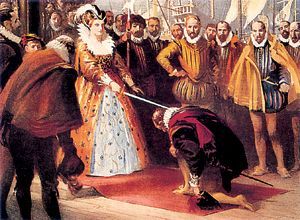時代背景
 弗朗西斯·德雷克
弗朗西斯·德雷克 1519年西班牙人找到了傳說中的黃金之國,在毀滅了阿茲特克和印加這兩支瑪雅人的後裔文明後,徹底控制了 南美大陸,控制了秘魯的金礦。為了壟斷與亞洲和美洲的貿易,他們封鎖了航路,嚴禁一切他國船隻的來往,非西班牙的船隻甚至連太平洋都沒有見過,太平洋變成了西班牙的私海。英法等國雖有怨氣,卻也是敢怒不敢言,只得通過奴隸貿易分一些油水。
生平履歷
1567年:德雷克第一次探險航行,從英國出發,橫越大西洋,到達加勒比海。
1569年:第二次探險航行,從加勒比海再往前,到達了中美洲。
1577年:第三次探險航行,德雷克循著麥哲倫的航線出發。由英國前往南大西洋,抵達了南美洲東海岸。
1578年:發現了合恩角和德雷克海峽,德雷克海峽就是用他的姓氏命名。8月時德雷克通過了南美洲南端最危險的麥哲倫海峽。在航程中,德雷克將艦隊旗艦鵜鶘號(Pelican)改名為金鹿號(Golden Hind),因為此船贊助人海頓爵士的徽章盾牌上是一隻金鹿。
1579年:德雷克與金鹿號在沿著南美洲西岸往北航行,北上一直航行到北緯48度的加拿大西海岸,發現無法通過北冰洋,只好改為橫越太平洋向西航行,經過菲律賓群島,穿過馬六甲海峽,橫越印度洋,繞好望角再次橫越大西洋。
1580年:9月26日,回到英國普利茅斯。外部聯結:三次遠航的地圖。
1581年:4月,女王伊莉莎白一世親自登船賜德雷克皇家爵士頭銜。
1588年:德雷克成為海軍中將,在軍旅中曾擊退西班牙無敵艦隊(Spanish Armada)攻擊。
1596年:1月27日,他因痢疾病逝於巴拿馬。
詳細經歷
一、初次探險
1567年德雷克第一次探險航行,從英國出發,橫越大西洋,到達加勒比海。
二、結怨
1568年,德雷克和他的表兄約翰·霍金斯從事販賣黑奴的生意,他們帶領五艘販奴船前往墨西哥,由於受到風暴襲擊,船隻受到嚴重損壞,起先,西班牙總督同意他們進港修理,但在幾天后突然下令攻擊,將英國船員全部處死,僅有德雷克和霍金斯逃離虎口,撿了一條命。從此以後他就有了一顆仇恨西班牙的心,他發誓在有生之年一定要向西班牙復仇,就此確定了其一生的軌跡。
三、二次探險
1569年第二次探險航行,從加勒比海再往前,到達了中美洲。
四、成名
 弗朗西斯·德雷克
弗朗西斯·德雷克 1577年,他再次從英國出發,乘著旗艦“金鹿”號直奔美洲沿岸,一路打劫西班牙商船,西班牙人做夢也想不到,竟然有人敢在“自家後院胡鬧”,當他們派出軍艦追擊時,德雷克早已逃往南方,但由於西班牙的封鎖,他無法通過狹窄的麥哲倫海峽,在一次猛烈的風暴中,“金鹿”號同船隊其它夥伴失散了,被向南吹了5°之多,來到了西班牙人也未曾到過的地方,自從麥哲倫海峽被發現以來人們一直認為海峽以南的火地島就是傳說中的南方大陸的一部分,但此時呈現在德雷克面前的是一片汪洋大海,德雷克被這意外的發現驚呆了,他很高興的向大家宣布“傳說中的南方大陸是不存在的,即使存在,也一定是在南方更寒冷的地方,”(直到今天我們還稱這片廣闊的水域為“德雷克海峽”),但德雷克卻一直向西橫渡了太平洋。
1579年7月23日,他到達了馬里亞納群島,8月22日穿過北回歸線,9月26日回到了闊別已久的普次茅斯港,再次成為了“民眾的英雄”,這次航行是繼麥哲倫之後的第二次環球航行,但德雷克卻是第一個自始至終指揮環球航行的船長(眾所周知,麥哲倫在菲律賓被土人做成三明治吃掉了)。德雷克帶回了數以噸計的黃金白銀,豐富了女王的腰包,更重要的是德雷克為英國開闢了一條新航路,大大促進了英國航海業的發展,而且他還發現了寬闊的德雷克海峽,自此以後,太平洋再也不是西班牙的海了,做為一個探險家德雷克的業績到此為止,但作為海戰史上著名的海戰專家,他的冒險才剛剛開始。
五、扭轉局勢
1587年,英國女王伊莉莎白處死了親西班牙的蘇格蘭女王瑪麗,西班牙對英宣戰,積怨已久的兩國終於拔劍相向,但當時,英國海軍還非常弱小,僅有三十四艘戰艦,根本無力與西葡聯盟作戰,危機時刻,德雷克帶領著25隻海盜船趕到了。沿著西班牙的海岸,德雷克開始“外科手術式的清洗”在加的斯港外他擊沉了36艘西班牙補給艦,接著又衝進加的斯港擊沉了33艘西班牙船隻,5月15日,德雷克艦隊突襲里斯本附近的舶錨地,在混亂中千百艘船隻相撞沉沒,損失無以估量。接著,他又攻占了聖維森特角要塞,扼住了地中海的咽喉,在回國的路上,他又打劫了西班牙國王菲利普二世的私人運寶船,搶到了價值11萬鎊的財富。由於這一系列的行動,戰爭至少延後了一年,從而為英國爭取到了寶貴的時間。
六、西班牙艦隊覆滅
1588年5月20日,由10個支隊,130條船艦組成的西班牙“無敵艦隊”從里斯本起航,7月19日,開始在英吉利海峽布陣,英國方面除三十四艘皇家海軍戰艦外,還有私人船艦60艘,前鋒是由34艘戰艦組成“德雷克支隊”,德雷克的表兄海盜船長霍金斯也趕來幫忙,兩人準備一起為當年死於墨西哥灣的同伴們報仇。英方的總指揮是霍華德勳爵,西班牙方面則是米地拉公爵領軍,此時的西班牙戰艦仍舊是以老式的樓船為主,這種船非常大除了水手外,還裝滿步兵,火力配備主要以重型的加農炮為主,作戰的西班牙海軍仍舊使用古老的橫隊戰術,即是讓艦船肩並肩的前進,用艦首炮轟擊後靠近敵船打接舷戰。十七年前,西班牙人就是憑藉著這種戰術取得了勒班托海戰的勝利,但此時英國人卻採用了更為先進的戰術,英國戰艦多為船身輕便的快帆船,除了水手外,不帶任何步兵,這種船靈活輕便,更易於轉向和突進,而且根本捨棄了“接舷戰”這種落後的方式,用德雷克的話說:“海上的事要由船來解決,和步兵沒有關係。”在火力配備方面英國人使用輕型的長炮且多布置在兩舷,戰鬥時則採用德雷克發明“縱隊戰術”,讓艦船首尾相接的排列,用舷炮轟擊,這是海戰史上的一次革命,自此以後火炮才取代步兵成為海戰的主角,就這樣在戰爭還沒開始前,西班牙艦隊覆滅的命運就已經注定好了。
七、巔峰狀態
7月22日晨英國艦隊借著順風,以“一條單長線”的隊型楔入西班牙艦隊,由於先進的戰術和靈活的機動性,沒有一艘船被西班牙陸軍搶占,到7月25日西班牙已經損失了十分之一的艦船,而英國方面則匯合了西莫爾勳爵的援軍使艦船總數達到136艘,7月28日晚,在德雷克等人的建議下,霍華德下令採取古老的火船戰術,(參看“赤壁之戰”)西班牙艦隊陣腳大亂,無法保持隊形,英艦趁機突擊。從29日上午9時,到下午6時,雙方艦隊在沒有編隊的情況下,互相混雜,三五成群的對射,直到都沒有炮彈為止,西班牙損失了近一半的船隻死傷1400人,英軍則一船未沉且死傷不足百人,這就是史上著名的英西大海戰,自此以後,西班牙一蹶不振,英國逐漸取代其成為海上的霸主,而德雷克則被封為英格蘭勳爵,登上海盜史上的最高峰。
傳記原稿
Francis Drake, eldest of twelve children,was born in Crowndale in about 1540. His father, Edmund Drake, was a passionate supporter of Martin Luther and during the Prayer Book Rebellion of 1948, was forced to flee with his family to Chatham in Kent.Drake was apprenticed to a Thames captain in the 1550s, and in 1563 joined his cousin, John Hawkins, on a voyage to Africa. The two men started capturing people in Sierra Leone and selling them as slaves to Spanish settlers in the Caribbean. As it was illegal for the settlers to buy from foreigners, Hawkins and Drake soon came into conflict with the Spanish authorities.
His first command was in 1567 when he took part in a successful attack on Spanish ships in the port of San Juan de Ulua. He returned to Plymouth with gold and silver worth over £40,000. Drake, a committed Protestant, saw himself as an instrument of God in his crusade against Philip II and the Spanish Empire. This was followed by voyages to the West Indies and in 1572 he seized gold and silver in the Americas and the Atlantic.
With the secret sponsorship of Elizabeth I, Francis Walsingham and Christopher Hatton, Drake continued to attack Spanish treasure ships. In 1579 he rounded the Straits of Magellan, and was the captain of the first ship, the Golden Hind, to sail into the Pacific Ocean. In June, 1579, he landed in California. When Drake arrived in England in September 1580, he became the first Englishman to circumnavigate the world.
Drake return to England as a very wealthy man and he was able to purchase the Buckland Abbey estate. In 1581 Elizabeth I knighted Drake and later that year he was elected to the House of Commons.
Drake carried out a successful raid of the Spanish Caribbean (1584-85) and managed to rescue the remaining English colonists in Virginia and returned to Portsmouth in 1586. He also led the expedition which wrecked the Spanish fleet at Cadiz in 1587.
In July 1588 131 ships in the Spanish Armada left for England. The large Spanish galleons were filled with 17,000 well-armed soldiers and 180 Catholic priests. The plan was to sail to Dunkirk in France where the Armada would pick up another 16,000 Spanish soldiers. The plan was to sail to Dunkirk in France where the Armada would pick up another 16,000 Spanish soldiers that were under the command of Alessandro Farnese, the Duke of Parma.On hearing the news Charles Howard of Effingham, Lord High Admiral, held a council-of-war. Lord Howard decided to divide the fleet into squadrons. Francis Drake, John Hawkins and Martin Frobisher were chosen as the three other commanders of the fleet.
Howard went in his flagship, the Ark Royal (800 tons and a crew of 250). Frobisher was given command of the largest ship in the fleet, the Triumpth (1,110 tons and a crew of 500 men) whereas Drake was the captain of the Revenge (500 tons and a crew of 250) and Hawkins was aboard the Victory (800 tons and a crew of 250).Lord Howard decided that the Spanish Armada should be attacked at both ends of the crescent. The Ark Royal attacked the right wing and the Revenge and the Triumph attacked Juan Martinez, de Recalde, commander of the Biscayan squadron on the left. Recalde on board the San Juan de Portugal decided to come out and fight the English ships. He was followed by Gran Grin and the two ships soon got into trouble and had to be rescued by the Duke of Medina Sidonia on board the San Martin.At the end of the first day's fighting, only one ship was sunk. This was Spain's San Salvador when a tremendous explosion tore
out its stern castle and killed 200 members of the crew. It was later discovered that a gunner's carelessness resulted in a spark reaching the gunpowder in the rear hold.
The following morning Francis Drake and the crew of Revenge captured the crippled Rosario. This included Admiral Pedro de Vales and all his crew. Drake also found 55,000 gold ducats on board.That afternoon Medina Sidonia announced that if any Spanish ship broke formation the captain would be hanged immediately. He also told his captains that they must maintain a tight formation in order to prevent further attacks from the English ships. This decision meant that they could only move towards Dunkirk at the speed of the slowest ship.Constantly harassed by the English ships the slow moving Spanish Armada eventually reached Calais without further loss. The English fleet now dropped anchor half a mile away. Soon afterwards they were joined by Lord Henry Seymour and his squadron of ships that had been controlling the seas off Dunkirk. This increased the English fleet by a third and was now similar in size to that of the Spanish fleet.
The Duke of Medina Sidonia now sent a message to the Duke of Parma in Dunkirk: "I am anchored here two leagues from Calais with the enemy's fleet on my flank. They can cannonade me whenever they like, and I shall be unable to do them much harm in return." He asked Parma to send fifty ships to help him break out of Calais. Parma was unable to help as he had less than twenty ships and most of those were not yet ready to sail.
That night Medina Sidonia sent out a warning to his captains that he expected a fire-ship attack. This tactic had been successfully used by Francis Drake in Cadiz in 1587 and the fresh breeze blowing steadily from the English fleet towards Calais, meant the conditions were ideal for such an attack. He warned his captains not to panic and not to head out to the open sea. Medina Sidonia confidently told them that his patrol boats would be able to protect them from any fire-ship attack that took place.Medina Sidonia had rightly calculated what would happen. Charles Howard and Francis Drake were already organizing the fire-ship attack. It was decided to use eight fairly large ships for the operation. All the masts and rigging were tarred and all the guns were left on board and were primed to go off of their own accord when the fire reached them. John Young, one of Drake's men, was put in charge of the fire-ships.
Soon after midnight the eight ships were set fire to and sent on their way. The Spaniards were shocked by the size of the vessels. Nor had they expected the English to use as many as eight ships. The Spanish patrol ships were unable to act fast enough to deal with the problem. The Spanish captains also began to panic when the guns began exploding. They believed that the English were using hell-burners (ships crammed with gunpowder). This tactic had been used against the Spanish in 1585 during the siege of Antwerp when over a thousand men had been killed by exploding ships.The fire-ships did not in fact cause any material
damage to the Spanish ships at all. They drifted until they reached the beach where they continued to burn until the fire reached the water line. Medina Sidonia, on board the San Martin, had remained near his original anchorage. However, only a few captains had followed his orders and the vast majority had broken formation and sailed into the open sea.
At first light Medina Sidonia and his six remaining ships left Calais and attempted to catch up with the 130 ships strung out eastwards towards the Dunkirk sandbanks. Some Spanish ships had already been reached by the English fleet and were under heavy attack. San Lorenzo, a ship carrying 312 oarsmen, 134 sailors and 235 soldiers, was stranded on the beach and was about to be taken by the English.With their formation broken, the Spanish ships were easy targets for the English ships loaded with guns that could fire very large cannon balls. The Spanish captains tried to get their ships in close so that their soldiers could board the English vessels. However, the English ships were quicker than the Spanish galleons and were able to keep their distance.
The battle of Gravelines continued all day. One of the most exciting contests was between Francis Drake in the Revenge and Duke of Medina Sidonia in the San Martin. Drake's ship was hit several times before being replaced by Thomas Fenner in the Nonpareil and Edmund Sheffield in the White Bear, who continued the fight without success.All over the area of sea between Gravelines and Dunkirk fights took place between English and Spanish ships. By late afternoon most ships were out of gunpowder. The Duke of Medina Sidonia was now forced to head north with what was left of the Spanish Armada. The English ships did not follow as Charles Howard of Effingham, Lord High Admiral, was convinced that most Spanish ships were so badly damaged they would probably sink before they reached a safe port.That evening Francis Drake wrote to a friend: "God hath given us so good a day in forcing the enemy so far to leeward, as I hope in God the Duke of Parma and the Duke of Sidonia shall not shake hands this few days".
After the Armada rounded Scotland it headed south for home. However, a strong gale drove many of the ships onto the Irish rocks. Thousands of Spaniards drowned and even those who reached land were often killed by English soldiers and settlers. Of the 25,000 men that had set out in the Armada, less than 10,000 arrived home safely.Drake led a disastrous attack on Portugal in 1589. He returned to England and became mayor of Plymouth in 1593. He went on another exhibition to the Caribbean in 1595 and the following year died of dysentery at Porto Bello.
人物紀念
1937年-1970年,有33年的時間,英國的錢幣半便士(Half Penny)上一直以德雷克的金鹿號為圖案。英國文化中有一首民謠叫做“德雷克的鼓(Drake's drum) ”,大意是說,如果英國蒙難,只要德雷克的鼓又響了,他就一定會回來為英國解難。
其他信息
據美國一家海盜博物館的訊息稱,在巴拿馬海域找到了傳奇航海家弗朗西斯·德雷克的沉船。由於經過了4個世紀的歲月,兩艘船破損均非常嚴重。據稱,目前可判斷是德雷克的船員在他死後將船沉入了海底。詳細情況還有待進一步證實。
![德雷克[英國探險家、著名海盜] 德雷克[英國探險家、著名海盜]](/img/f/f45/nBnauM3XwQTO1gjN2ETMzczN0QTM4YjM2cDNzQTNwAzMwIzLxEzL2YzLt92YucmbvRWdo5Cd0FmLzE2LvoDc0RHa.jpg)

